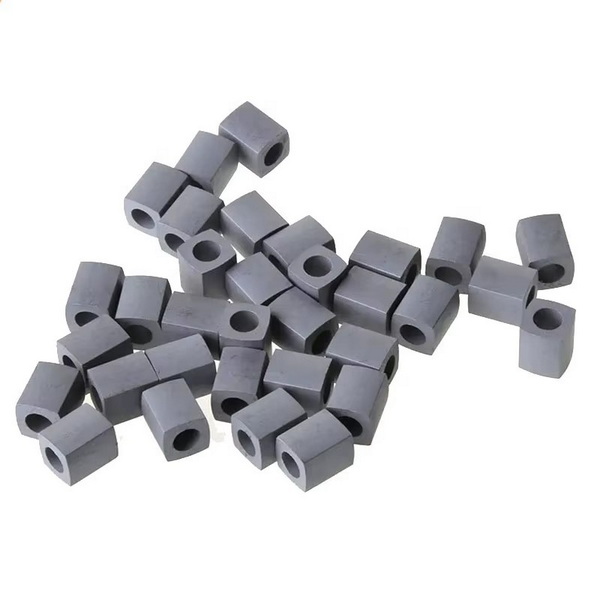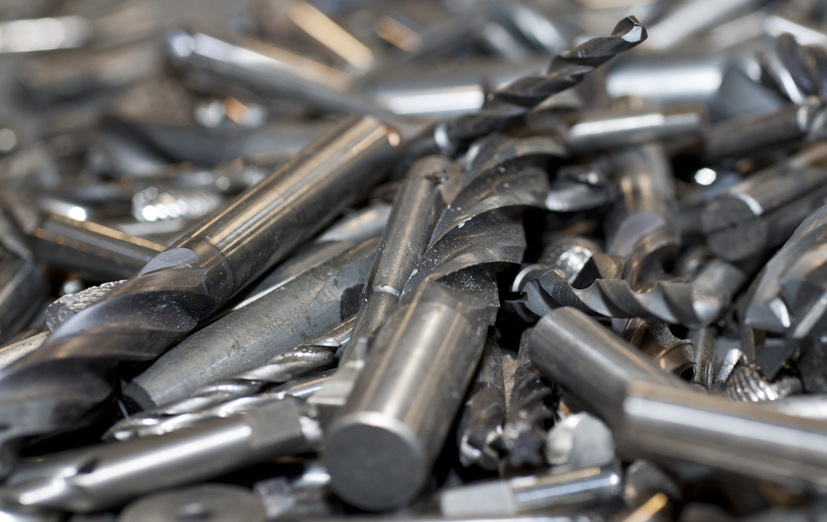Content Menu
● Understanding Conductivity in Materials
● The Conductivity of Tungsten Carbide
● Properties of Tungsten Carbide
● Thermal and Electrical Conductivity
● Applications of Tungsten Carbide
● Advantages of Using Tungsten Carbide
● Limitations of Tungsten Carbide
● Types and Grades of Tungsten Carbide
● Case Studies Showcasing Real-World Applications
● Comparative Analysis with Other Materials
● Future Trends in Tungsten Carbide Use Across Industries
● Safety Considerations When Using Tungsten Carbide
● Conclusion
● FAQ
>> 1. Does tungsten carbide conduct electricity?
>> 2. What are the main uses of tungsten carbide?
>> 3. How hard is tungsten carbide compared to other materials?
>> 4. Is tungsten carbide safe for people with sensitive skin?
>> 5. Can tungsten carbide be recycled?
● Citations:
Tungsten carbide (WC) is a composite material made from tungsten and carbon, known for its exceptional hardness and durability. Its applications span various industries, including manufacturing, mining, and jewelry. A common question that arises regarding tungsten carbide is whether it conducts electricity. This article explores the conductivity of tungsten carbide, its properties, applications, and addresses frequently asked questions.
 X
X
Understanding Conductivity in Materials
Conductivity refers to the ability of a material to conduct electric current. Materials are generally classified into three categories based on their conductivity:
- Conductors: Materials that allow electricity to flow easily (e.g., copper, silver).
- Insulators: Materials that do not conduct electricity (e.g., rubber, glass).
- Semiconductors: Materials that have conductivity between conductors and insulators (e.g., silicon).
The Conductivity of Tungsten Carbide
Tungsten carbide is often misunderstood regarding its electrical properties. Here are the key points:
- Industrial Form: In its industrial form, tungsten carbide does exhibit some level of electrical conductivity, comparable to tool steel and carbon steel. This means it can conduct electricity but not as effectively as metals like copper or silver.
- Jewelry Form: When tungsten carbide is used in jewelry (such as rings), it is typically in a cemented form where it becomes more ceramic-like. In this state, its electrical conductivity is significantly reduced, making tungsten carbide rings non-conductive. This characteristic is beneficial for safety reasons, particularly for electricians and those working in environments where electrical hazards exist.
Properties of Tungsten Carbide
Tungsten carbide possesses several notable properties that contribute to its widespread use:
- Hardness: Tungsten carbide ranks between 8.5 and 9.5 on the Mohs scale, making it one of the hardest materials available, second only to diamond.
- Density: It has a high density (approximately 15 g/cm³), which allows it to be used in applications requiring heavy materials without increasing volume.
- Thermal Stability: Tungsten carbide can withstand high temperatures without losing its structural integrity, making it suitable for cutting tools and machinery exposed to heat.
- Wear Resistance: It exhibits exceptional wear resistance, allowing tools made from tungsten carbide to last significantly longer than those made from other materials.
Thermal and Electrical Conductivity
Tungsten carbide has unique thermal and electrical conductivity characteristics:
- Thermal Conductivity: Tungsten carbide conducts heat much more rapidly than tool steel. Its thermal conductivity can be approximately twice that of unalloyed steels and about one-third that of copper. This property makes tungsten carbide ideal for applications where heat resistance and thermal conductivity are essential.
- Electrical Conductivity: The electrical conductivity of tungsten carbide varies based on its composition. Generally, the conductivity increases with higher cobalt content in the binder phase. However, even at its most conductive grade, tungsten carbide only reaches about 10% of copper's conductivity. This low level of conductivity makes it suitable for applications where some electrical resistance is desirable[1][3][11].
Applications of Tungsten Carbide
The unique properties of tungsten carbide make it suitable for various applications:
- Cutting Tools: Its hardness and wear resistance make tungsten carbide ideal for manufacturing cutting tools used in machining metals and other hard materials.
- Mining Tools: Tungsten carbide is used in drill bits and other mining equipment due to its durability under extreme conditions.
- Jewelry: Tungsten carbide rings are popular for their scratch resistance and modern aesthetic. They are often marketed as hypoallergenic due to their low reactivity with skin.
- Industrial Machinery: Components made from tungsten carbide are used in machinery that requires high precision and durability.
Advantages of Using Tungsten Carbide
The advantages of using tungsten carbide extend beyond its hardness:
- Corrosion Resistance: Tungsten carbide is highly resistant to corrosion, making it suitable for harsh environments.
- Longevity: Tools made from tungsten carbide have a longer lifespan compared to those made from other materials due to their wear resistance.
- Versatility: Tungsten carbide can be molded into various shapes and sizes for different applications, making it a versatile material in manufacturing processes.
Limitations of Tungsten Carbide
While tungsten carbide has numerous advantages, there are some limitations:
- Brittleness: Although hard, tungsten carbide can be brittle under certain conditions. Care must be taken during handling to avoid chipping or breaking.
- Cost: The production cost of tungsten carbide can be higher than other materials due to the complexity involved in manufacturing processes.
The manufacturing process of tungsten carbide involves several critical steps that ensure the material's exceptional properties:
1. Powder Preparation:
- The process begins with mixing finely powdered tungsten metal with carbon powder at high temperatures (around 1,400°C). This reaction forms tungsten carbide powder through a chemical reaction known as carburization.
2. Sintering:
- The resulting powder is then compacted into desired shapes using high pressure (up to several tons). This compacted form is then heated again in a controlled atmosphere during sintering—typically at temperatures around 1,500°C—to achieve densification without melting the material completely.
3. Binder Addition:
- Most grades include a binder (commonly cobalt or nickel) added during the mixing stage before pressing or sintering. The binder enhances toughness while retaining hardness.
4. Machining:
- After sintering, components may undergo machining processes such as grinding or polishing to achieve precise dimensions and surface finishes required for specific applications[12][18].

Types and Grades of Tungsten Carbide
Different grades of tungsten carbides offer varying properties suited for specific applications:
- Cemented Carbides (WC-Co):
- The most common type consists predominantly of WC particles bonded with cobalt or nickel binders.
- These grades exhibit excellent wear resistance while maintaining toughness—ideal for cutting tools and machining applications[14][19].
- Ultra-Fine Grain Carbides:
- These contain sub-micron grain sizes that enhance hardness but may sacrifice impact resistance.
- Suitable for precision tools requiring sharp edges[10][22].
- Coated Carbides:
- Many tools are coated with additional materials like titanium nitride (TiN) or aluminum oxide (Al2O3) to improve wear resistance further and reduce friction during machining[11][12].
Case Studies Showcasing Real-World Applications
1. Aerospace Industry:
- In aerospace manufacturing processes where precision components are crucial—such as turbine blades—tungsten carbides are employed due to their ability to withstand extreme conditions while maintaining dimensional accuracy[18][19].
2. Mining Operations:
- Drill bits made from cemented carbides demonstrate outstanding performance when drilling through hard rock formations—extending tool life significantly compared to traditional steel bits[12][19].
3. Medical Instruments:
- Surgical instruments manufactured from high-grade tungsten carbides provide superior performance due to their hardness and corrosion resistance—ensuring longevity even under repeated sterilization cycles[9][14].
Comparative Analysis with Other Materials
When comparing tungsten carbides with other common materials used in similar applications:
| Property | Tungsten Carbide | Tool Steel | Ceramic |
| Hardness | 8.5 - 9.5 | 6 - 8 | 7 - 9 |
| Wear Resistance | Excellent | Moderate | Good |
| Toughness | High | Moderate | Low |
| Thermal Stability | High | Moderate | High |
| Cost | Higher | Lower | Variable |
This table illustrates that while tool steels may be less expensive upfront than tungsten carbides, they do not offer comparable longevity or performance under extreme conditions[12][19].
Future Trends in Tungsten Carbide Use Across Industries
As industries evolve towards more durable materials capable of performing under extreme conditions:
1. Green Technologies:
- With increasing focus on sustainability practices within manufacturing sectors—tungsten carbides' recyclability positions them favorably against traditional metals[6][10].
2. Advanced Coatings Development:
- Research into coatings that further enhance performance characteristics could see expanded usage across sectors such as automotive or aerospace where weight reduction combined with strength is paramount[11][18].
3. Electronics Industry Applications:
- As electronic devices become smaller yet more powerful—tungsten carbides may find new roles within microelectronics due to their unique combination of thermal stability and strength[24].
4. Additive Manufacturing Techniques:
- Emerging technologies like additive manufacturing could revolutionize how components are produced using powdered metals—including advanced formulations involving tungsten carbides tailored specifically for niche applications[10][22].
Safety Considerations When Using Tungsten Carbide
While utilizing tools made from tungsten carbides provides numerous benefits; certain safety considerations must also be addressed:
1. Handling Precautions:
- Due care should be taken when handling brittle components—especially during machining processes where chips may pose risks if not properly managed[16][20].
2. Electrical Safety Standards:
- For professionals working around electrical systems—non-conductive forms (like jewelry) provide an added layer of protection against accidental shocks[24].
3. Dust Control Measures:
- During machining operations generating fine dust particles—appropriate ventilation systems should be employed along with protective gear such as masks or respirators[15][20].
Conclusion
In summary, tungsten carbide does have conductive properties in its industrial form but becomes non-conductive when used in jewelry due to its ceramic-like structure. Its hardness, wear resistance, thermal stability, and corrosion resistance make it an invaluable material across many industries. Understanding the conductivity of tungsten carbide helps consumers make informed choices about its applications, especially when considering safety in electrical environments.

FAQ
1. Does tungsten carbide conduct electricity?
Yes, tungsten carbide can conduct electricity in its industrial form but is non-conductive when used as jewelry.
2. What are the main uses of tungsten carbide?
Tungsten carbide is primarily used in cutting tools, mining equipment, industrial machinery, and jewelry.
3. How hard is tungsten carbide compared to other materials?
Tungsten carbide ranks between 8.5 and 9.5 on the Mohs scale of hardness, making it one of the hardest materials available.
4. Is tungsten carbide safe for people with sensitive skin?
Yes, high-quality tungsten carbide rings are often hypoallergenic due to their low reactivity with skin.
5. Can tungsten carbide be recycled?
Yes, tungsten carbide can be recycled effectively due to its durability and value as a material.
Citations:
[1] https://wesltd.com/capabilities/materials/tungsten-carbide/
[2] https://shop.machinemfg.com/does-tungsten-conduct-electricity-key-facts-and-insights/
[3] https://www.hyperionmt.com/en/Resources/materials/cemented-carbide/electrical-and-magnetic-properties/
[4] https://eurobalt.net/blog/2022/03/28/all-the-applications-of-tungsten-carbide/
[5] https://www.vedantu.com/chemistry/tungsten-carbide
[6] https://www.thermalspray.com/why-is-tungsten-carbide-becoming-increasingly-popular/
[7] https://www.sollex.se/en/blog/post/tungsten-carbide-and-technology-part-2
[8] https://domadia.net/blog/is-tungsten-a-good-conductor-of-electricity/
[9] https://www.tungco.com/insights/blog/5-tungsten-carbide-applications/
[10] https://eternaltools.com/blogs/tutorials/tungsten-carbide-an-informative-guide
[11] https://carbideprocessors.com/pages/carbide-parts/tungsten-carbide-properties.html
[12] https://en.wikipedia.org/wiki/Tungsten_carbide
[13] https://www.hyperionmt.com/en/Resources/materials/cemented-carbide/thermal-properties/
[14] https://en.wikipedia.org/wiki/Tungsten_carbide
[15] https://www.linkedin.com/pulse/properties-tungsten-carbide-shijin-lei-2c
[16] https://patrickadairdesigns.com/blogs/blog/best-non-conductive-wedding-rings-for-electricians
[17] https://www.vedantu.com/question-answer/tungsten-is-a-bad-conductor-of-electricity-atrue-class-9-chemistry-cbse-5f7ea54587969e736558b017
[18] https://www.itia.info/applications-markets/
[19] https://www.carbide-usa.com/top-5-uses-for-tungsten-carbide/
[20] https://www.bangerter.com/en/tungsten-carbide
[21] https://www.dymetalloys.co.uk/what-is-tungsten-carbide/tungsten-carbide-grades-applications
[22] http://www.chinatungsten.com/Tungsten-Carbide/Properties-of-Tungsten-Carbide.html
[23] https://www.samaterials.com/content/what-are-the-applications-of-tungsten.html
[24] https://redwoodrings.com/blogs/redwood-rings-blog/are-tungsten-rings-conductive
[25] https://www.samaterials.com/content/application-of-tungsten-in-modern-industry.html









 X
X




